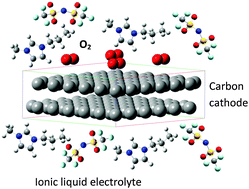A density functional theory based study of the electron transfer reaction at the cathode–electrolyte interface in lithium–air batteries†
Abstract
The unique properties of ionic liquids such as a relatively wide electrochemical stability window and very low vapor pressure have made them promising candidates as electrolytes for improving the cyclic performance of lithium–air batteries. The local current density, which is an important parameter in determining the performance of lithium–air batteries, is a function of the rate constant of the electron transfer reactions at the surface of the cathode. In this study, a novel method based on Marcus theory is presented to investigate the effect of varying the length of the alkyl side chain of model imidazolium based cations and the operating temperature on the rates of electron transfer reactions at the cathode. The necessary free energies of all the species involved in the multi-step reduction of oxygen into the peroxide ion were calculated using density functional theory (DFT). Our results indicate that the magnitude of the Gibbs free energy for the reduction of oxygen into the superoxide ion and also for the reduction of superoxide into the peroxide ion increases with an increase in the static dielectric constant of the ionic liquid. This trend in turn corresponds to the decrease in the length of the alkyl side chain of the ionic liquid cation. Furthermore, the change in Gibbs free energy decreases with increase in the operating temperature. The inner-sphere reorganization energies were evaluated using Nelsen's four point method. The total reorganization energies of all reduction reactions increase with decrease in the length of the alkyl side chain and increase in the operating temperature. Finally, the rate constants of the electron transfer reaction involved in the reduction of oxygen were calculated. The logarithm of the reaction rate constants decreases with increase in the static dielectric constant and increases with increase in the operating temperature. Our results provide fundamental insight into the kinetics and thermodynamics of the electron transfer reactions at the cathode that will help in the identification of appropriate electrolytes for enhanced performance of lithium–air batteries.


 Please wait while we load your content...
Please wait while we load your content...